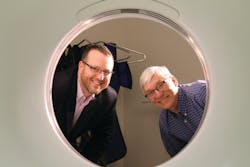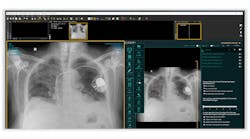When a physician orders an imaging study for a particular reason – to examine a liver, for instance — sometimes there are findings with other organ systems that should be followed up on. Patients with significant imaging findings may require follow-up imaging studies, surveillance or other evaluations at prescribed intervals. But because the radiologists’ findings are incidental to the reason the study was ordered in the first place and may not be as acute, they often are not tracked by healthcare systems, which could lead to late or missed diagnoses.
Clinical leaders at Kaiser Permanente Colorado (KPCO) realized that they had no system in place to ensure that adequate surveillance and additional evaluations consistently occurred. Therefore, it was difficult to ensure compliance with recommended follow-up for their patients. They set out to create a tracking system for such radiological findings.
“There are a lot of non-urgent imaging findings, but follow-up is over six or 12 months,” explains project leader Richard Sharpe Jr., M.D., a breast imaging subspecialist and chair of the interregional clinical practice group for radiology at Permanente Medicine in Colorado. Previously this was handled by doctors making themselves notes on the side of a chart to try to remember something or by asking the patient to help them remember, he adds. “We re-engineered the healthcare system that delivers the care to have time-delay triggers to bring these issues to people’s attention and work flows when that reminder is needed. That is our fundamental innovation.”
A KPCO multidisciplinary team developed a program to identify patients with significant incidental imaging findings and create an automated imaging finding tracking and management system. This effort, piloted in 2018 and 2019, has now gone live in Kaiser’s Colorado region and is likely to be rolled out across other Kaiser regions in the next few years. This project, which involved radiologists and imaging informatics executives as well as clinical quality, patient safety and risk management officials, wins Healthcare Innovation’s second-place Innovator Award for 2020 because of its potential to scale up and have a significant impact on patient outcomes.
For the KPCO region alone, between October 2018 and March 2019, the team identified 583 radiology reports that contained at least one imaging finding that was significant enough that it required entry into the patient tracking and management system. By reducing delayed and missed diagnoses and increasing appropriate surveillance and management of these patients, KPCO’s goal is better quality patient care and outcomes.
Developing practice parameters
Radiology imaging studies are commonly dictated by the radiologist and transcribed into free-text reports. These free-text reports are transmitted to the electronic health record (EHR) as non-structured, non-codified free-text reports. The lack of structure limits the ability to consistently and accurately identify patients with potentially significant imaging findings from patients with nonsignificant findings.
To tackle this issue, the KPCO Department of Medical Imaging collaborated with many specialties in KPCO and other Kaiser regions to create practice parameters to enable concise, consistent and standardized management of various imaging findings. “We created 11 groups each with 10 radiologists who met two to three times for an hour each,” Sharpe explains. “We went through the evidence and came up with agreements on how we were going to classify conditions, what we were going to call them and what we are going to recommend when we saw them. We have about 100 different findings tracks.”
Once they had that agreement, they could hardwire many of these parameters of care into their radiology reporting system, which allows radiologists to make standardized text recommendations. “That was a real win for the radiologists,” Sharpe says, “because previously we had to spend a few minutes thinking about what to say, how to say it, and what to recommend. Now we have tables and care pathways, so we can just click on the appropriate one.”
In addition, standardized dictation “macros” were developed and integrated into the imaging voice recognition, dictation-to-text software system. “We wanted to use natural language processing (NLP),” says Ted Palen, Ph.D., M.D., informatics physician investigator in Kaiser Permanente’s Institute for Healthcare Research. “Indeed, NLP has become much more robust, but it is still difficult to process free text totally using NLP because of false positives and negatives. But if we have standardized language, it is a lot easier to access those findings we are interested in looking for. The added benefit is these standardized macros prompt the radiologist to assign a track code that designates the kind of follow-up that is needed and how often. By combining NLP and track codes, we have greater accuracy in how we can put them into our registry system.”
When the radiologist says, “macro incidental,” the system populates instructions for the findings tracking management tool, which sits outside the EHR. The dictation macro also allows the radiologist to add a description of the finding, a diagnosis, and follow-up recommendations into the radiology report. The imaging finding/diagnosis is automatically placed on the patient’s problem list within their EHR chart. The patient is also entered into the tracking surveillance system, which automatically places appropriate follow-up orders for imaging studies into the EHR order-entry system.
The diagnosis and recommended follow-up go into the report in a standardized format, Sharpe adds. “Our IT systems keep an eye on this language and trigger downstream actions. The finding automatically appears on the patient’s problem list, so a doctor caring for them sees it as an actionable item; it triggers future MRIs to be ordered in six months,” he says. “We can trigger that to show up in the system, and the patient is contacted through a secure message on the portal to schedule it.”
The system also enters the tracking information into a Care Gap population management tracking tool. This creates an electronic safety net to ensure follow-up occurs and enables metric-based reporting for the management of both patients and system performance.
KPCO also created a graphical interface to allow the provider to sit with the patient in the office to say, ‘Look, over the next year you are going to need these four tests. This is the care path we are going to help you complete.’ “It is a different kind of patient care that is supportive and just in time,” Sharpe says, “because it is what they need when they need it.”
After piloting the tracking system for several months, they went live in Colorado in late 2019, and KPCO is gradually introducing modules for different organ systems. “We have five organ systems going right now with many more in the pipeline to roll out this year,” Palen says. “As we went from pilot to full-scale model, we have been able to put it on the EHR problem list, put it in the tracking system, send a notification to the primary care physician and the patient. Just since we went live, 30 findings have been identified. We are very excited about it.”
Rolling out such a system took about a year’s worth of training work with radiologists on the practice parameters and how to use the software.
“Right away we saw there was good uptake,” Sharpe says. “Radiologists like using this because it allows them to offload some of that additional work they do of thinking how to describe a finding like this. Patients like it because they feel it offers them clear communication. Quality and IT people like it because it allows us to make sure that these findings got followed.”
Uncharted waters
One challenge in creating the system, Sharpe adds, is that these are relatively uncharted waters. “There is not a blueprint we could look to in order to design this architecture. I might call it a proof of concept rather than a pilot. We are in a new space where we had to answer the question, can we pull this into the Epic EHR and execute downstream actions?”
Part of that challenge, he adds, was envisioning what was needed and making sure they took care of all the subtle points. For instance, some patients might not want follow-up, and some doctors might decide it isn’t necessary for this patient. “We had to create mechanisms to account for those situations,” he says.
Could artificial intelligence help with efforts like this in the future? Palen notes that 2020 is being called the year of artificial intelligence. “There is a lot of talk about using AI algorithms to try to do these types of things,” he says, “but AI is still in its infancy, and a lot of research studies and pilots are being done without true implementations yet. I expect it is going to come; it is just that I am not aware of any other systematic approach to doing this right now.”
Scaling up within Kaiser
Kaiser Permanente has some advantages in developing, studying and scaling up innovations. It operates in eight regions across the United States and has more than 630,000 members who are cared for by more than 1,200 physicians and 6,000 ancillary staff.
“Being an integrated healthcare system allows a majority of our patients to be interpreted by a fixed group of radiologists on a common medical record,” Sharpe adds. “Our patients use our portal and our providers are generally in the same system and are familiar with managing it. Having all that in the same IT ecosystem gives us some competitive advantage for innovation like this.”
Sharpe and Palen say other Kaiser regions have expressed interest in adopting the tracking system. “Because it is such a big undertaking, other regions will also be doing this in a stepwise approach,” Palen notes. “They don’t have to do long, drawn-out pilots, but they can decide which organs to turn on first.” Lung and pelvic exams are high priorities as are kidney and pancreas. “Pancreatic cancer is devastating with poor prognosis. Being able to do early detection of pancreatic lesions is so important,” he says.
Most Kaiser regions are quite curious about how they can transfer the learning to their regions, Sharpe adds. “Because we have the inter-regional practice parameters that began about two years ago, they are already on board with standardized interpretation. We are creating a patient-centered care mechanism and safety net to standardize high-quality care. This is just the IT infrastructure to support that effort.”
Palen sees three main keys to project success: “The really important thing is the education of the radiologists about how to standardize the approach to reporting, which makes the extraction of the data to put into a registry for surveillance system much easier,” he says. “It also takes a lot of coordination from informatics people to be able to do the nuts-and-bolts software programming, as well as the buy-in and sponsorship from leadership to get it accomplished.”
He summarizes it this way: “Patients have never had this kind of notification that says, ‘Hey, we found something that is incidental to what you went in for, but we are going to track it for you.’ It is a different mindset about how to do this type of proactive care.”


